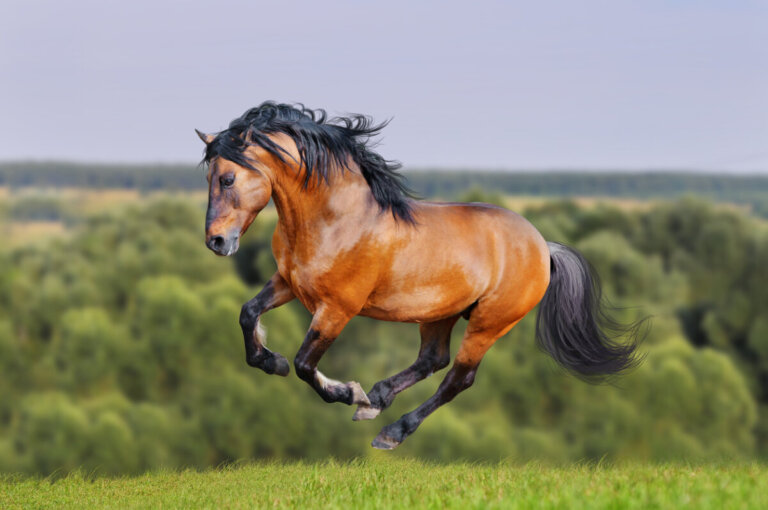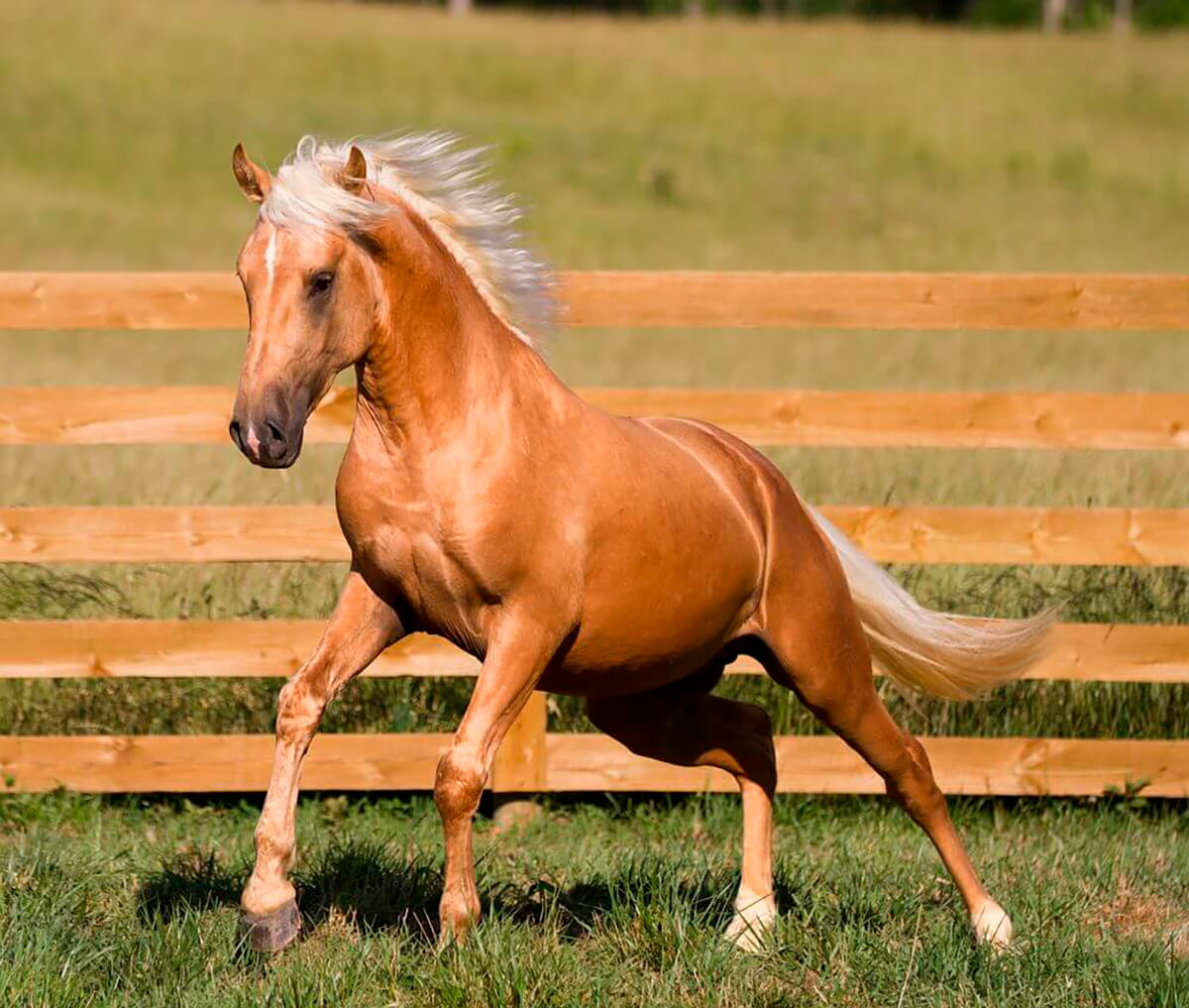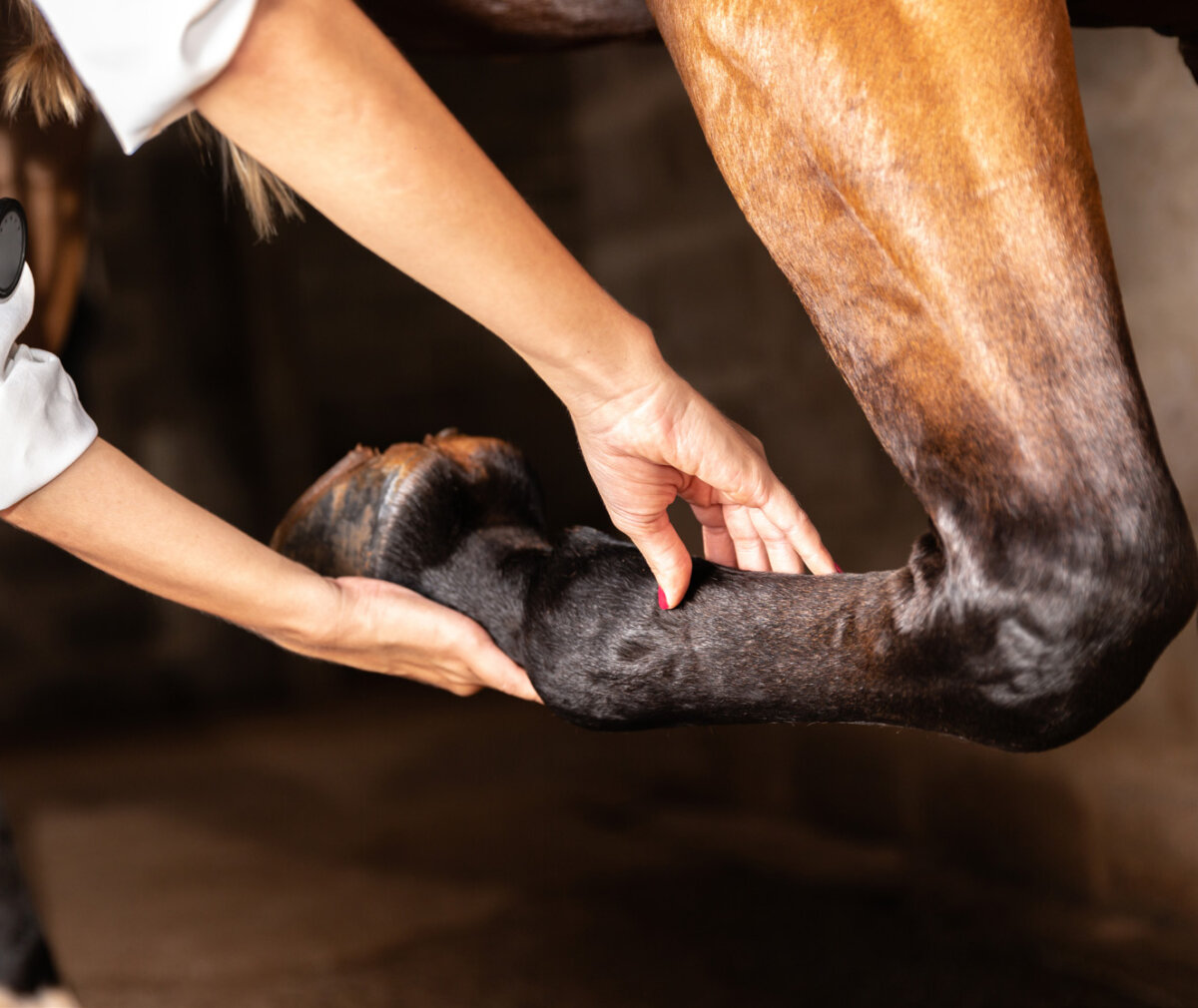The Lusitano Horse: What You Should Know About this Breed


Written and verified by the veterinarian and zootechnician Sebastian Ramirez Ocampo
With exceptional characteristics, the Lusitano horse has awakened the admiration of all, both those who are familiar with the equestrian world and those who aren’t. In fact, its genetics have served as the basis for many of the “thoroughbred” breeds found today.
Although it’s originally from Portugal, its beauty and dexterity have transcended the borders of that country, making it an animal that’s appreciated in different parts of the world. If you want to know more about this iconic horse, we recommend you read the information in the following article.
We’ll go over its origin, the characteristics that distinguish it, as well as its basic care requirements and the uses that the Lusitano horse has been given in different equestrian competitions. Don’t miss it!
Origin of the Lusitano horse
The Lusitano horse owes its name to the ancient Roman region of Lusitania. This territory covered what’s known today as Portugal, as well as some areas of western Spain.
Its earliest recorded ancestor is the Sorraia horse, a wild equine from the Iberian Peninsula that has existed for more than 25,000 years BC. This is according to the Colombian Association of Purebred Lusitano Horse Breeders (ACPSL).
According to this organization, the first crossbreeding of the Sorraia occurred in 3000 BC, with specimens from the Middle East and, empirically, from North Africa. However, it was during the reign of John V of Portugal, in 1748, that the search for a new breed with specific characteristics began:
- Docile
- Suitable for riding
- Good temperament
For this purpose, mares and breeding stallions were imported from Spain.
These were crossed with Portuguese horses and gave rise to the Alter Real lineage, as well as its two lines: The Vegia and the Andrade. It’s worth mentioning that the Lusitano horse, as it’s known today, was born from the crossbreeding of the latter two breeds.
Currently, there are an estimated 5,000 officially registered breeding mares, with a greater presence in the following countries:
- Brazil
- Mexico
- Spain
- France
- Portugal
However, as a study published in the journal Livestock Science warns, the genetic diversity of the breed has decreased in recent years. This is due to the progressive loss of the first specimens and their ancestors. In fact, the Portuguese Association of Purebred Lusitano Horse Breeders (APSL) has cataloged the Lusitano horse as a breed in danger of extinction.
Physical characteristics
It’s a baroque horse–a term used to describe robust but agile equines–of medium volume, with a perfect combination of mass and traction. In adulthood, it can weigh up to 1100 pounds and reach a height of 5 feet in the case of females and 5.25 feet in males.
Its head is of medium length, well proportioned, and with not very pronounced features. Its ellipse-shaped eyes are wide open, large, and expressive, while its ears are medium-sized, thin, and slender.
The trunk is composed of strong and resistant musculature, which allows it to distribute its power evenly. In addition, thanks to the power of its rump and its long limbs, the Lusitano horse can reach high speeds in a matter of seconds.
The color of its coat can be found in the following shades:
- Thoroughbred: This is considered the most common. It consists of a gray coat with white spots in various shapes.
- Chestnut: It can be complete or with white spots on the face or limbs.
- Palomino: It appears as a coat of golden ochre color, with a white mane and tail.
- Cremello: Uncommon and highly sought after for its rarity. It’s a uniform yellowish-white color, although the mane and tail exhibit black or white tones.

The temperament of the Lusitano horse
The Lusitano horse is a very appreciated equine thanks to its temperament, nobility, and balanced character. Its personality, intelligence, and learning capacity stand out in its personality. In addition, it has a great ability to make quick decisions, which allows it to avoid obstacles, even when going at high speed.
Thanks to this, it’s a horse widely used in equestrian competitions, such as the following:
- Dressage
- Equestrian jumping
- Cowboy dressage
Among other things, because of its athletic aptitudes, the Luisitano horse is always eager and willing to face demanding work or training days.
In fact, a study published in the journal Animals reported that dogs subjected to high-intensity exercise manage lower stress levels, as well as better physical condition and overall well-being.
General care
In order to achieve optimal welfare of the species, it’s essential to provide it with an adequate diet. This should be composed of elements of vegetable origin, such as those mentioned below:
- Hay
- Pasture
- Green fodder
Grain or concentrated feeds should be avoided to a greater extent, as they’re more difficult for horses to digest.
In addition to this, feed should be given in small portions and relatively frequently. As an example, it’s recommended to give 3 to 4 daily rations of 5.5 pounds each. This is because the equine gastrointestinal system is small, so an oversaturation of feed can result in gastric impaction and colic.
Among other things, according to the portal Kentucky Equine Research, equines can lose electrolytes, such as sodium and chlorine, through intense sweating. In view of this, experts recommend supplementing their diet with salt, at a dose of 1.5 ounces per pound of weight.
At the same time, given its athletic characteristics and exercise needs, the Lusitano horse must have a large place where it can ride and burn off its energy. In addition, it’s necessary to have a space to be protected from inclement weather.
The health of the Lusitano horse
With proper care, a Lusitano horse can have a life expectancy of 20 to 30 years. However, like any living being, it’s not exempt from suffering from certain diseases. For example, as a recent study in the Journal of Equine Veterinary Science points out, the Lusitano horse can suffer from a joint disease called osteochondrosis dissecans.
In this pathology, the bone underneath the cartilage dies due to lack of irrigation. Therefore, it detaches and causes strong symptoms of pain and difficulty of movement in the affected area.
It usually occurs to a greater extent in the tarsal joint, located in the hind limbs.
However, as reported in a study published in the same journal, other musculoskeletal conditions, such as osteoarthritis, have a low prevalence in the Lusitano horse. At the same time, if the equine is used in sports competitions, it can develop some other frequent diseases, such as hoof fractures or tendinitis.

An exceptional equine
As you’ve been able to observe, the physical and behavioral characteristics linked to the breed make the Lusitano horse a specimen qualified for any type of work. Thanks to the genetics of its strong, beautiful, and resistant ancestors, this equine can perform both in physically intense activities, as well as in parades and equestrian exhibitions.
If you’re in the equestrian world, or you’re just interested in sports competitions, starting with a Lusitano horse will always be one of the best options. Always remember to provide basic care and ask for health advice from a competent professional.
With exceptional characteristics, the Lusitano horse has awakened the admiration of all, both those who are familiar with the equestrian world and those who aren’t. In fact, its genetics have served as the basis for many of the “thoroughbred” breeds found today.
Although it’s originally from Portugal, its beauty and dexterity have transcended the borders of that country, making it an animal that’s appreciated in different parts of the world. If you want to know more about this iconic horse, we recommend you read the information in the following article.
We’ll go over its origin, the characteristics that distinguish it, as well as its basic care requirements and the uses that the Lusitano horse has been given in different equestrian competitions. Don’t miss it!
Origin of the Lusitano horse
The Lusitano horse owes its name to the ancient Roman region of Lusitania. This territory covered what’s known today as Portugal, as well as some areas of western Spain.
Its earliest recorded ancestor is the Sorraia horse, a wild equine from the Iberian Peninsula that has existed for more than 25,000 years BC. This is according to the Colombian Association of Purebred Lusitano Horse Breeders (ACPSL).
According to this organization, the first crossbreeding of the Sorraia occurred in 3000 BC, with specimens from the Middle East and, empirically, from North Africa. However, it was during the reign of John V of Portugal, in 1748, that the search for a new breed with specific characteristics began:
- Docile
- Suitable for riding
- Good temperament
For this purpose, mares and breeding stallions were imported from Spain.
These were crossed with Portuguese horses and gave rise to the Alter Real lineage, as well as its two lines: The Vegia and the Andrade. It’s worth mentioning that the Lusitano horse, as it’s known today, was born from the crossbreeding of the latter two breeds.
Currently, there are an estimated 5,000 officially registered breeding mares, with a greater presence in the following countries:
- Brazil
- Mexico
- Spain
- France
- Portugal
However, as a study published in the journal Livestock Science warns, the genetic diversity of the breed has decreased in recent years. This is due to the progressive loss of the first specimens and their ancestors. In fact, the Portuguese Association of Purebred Lusitano Horse Breeders (APSL) has cataloged the Lusitano horse as a breed in danger of extinction.
Physical characteristics
It’s a baroque horse–a term used to describe robust but agile equines–of medium volume, with a perfect combination of mass and traction. In adulthood, it can weigh up to 1100 pounds and reach a height of 5 feet in the case of females and 5.25 feet in males.
Its head is of medium length, well proportioned, and with not very pronounced features. Its ellipse-shaped eyes are wide open, large, and expressive, while its ears are medium-sized, thin, and slender.
The trunk is composed of strong and resistant musculature, which allows it to distribute its power evenly. In addition, thanks to the power of its rump and its long limbs, the Lusitano horse can reach high speeds in a matter of seconds.
The color of its coat can be found in the following shades:
- Thoroughbred: This is considered the most common. It consists of a gray coat with white spots in various shapes.
- Chestnut: It can be complete or with white spots on the face or limbs.
- Palomino: It appears as a coat of golden ochre color, with a white mane and tail.
- Cremello: Uncommon and highly sought after for its rarity. It’s a uniform yellowish-white color, although the mane and tail exhibit black or white tones.

The temperament of the Lusitano horse
The Lusitano horse is a very appreciated equine thanks to its temperament, nobility, and balanced character. Its personality, intelligence, and learning capacity stand out in its personality. In addition, it has a great ability to make quick decisions, which allows it to avoid obstacles, even when going at high speed.
Thanks to this, it’s a horse widely used in equestrian competitions, such as the following:
- Dressage
- Equestrian jumping
- Cowboy dressage
Among other things, because of its athletic aptitudes, the Luisitano horse is always eager and willing to face demanding work or training days.
In fact, a study published in the journal Animals reported that dogs subjected to high-intensity exercise manage lower stress levels, as well as better physical condition and overall well-being.
General care
In order to achieve optimal welfare of the species, it’s essential to provide it with an adequate diet. This should be composed of elements of vegetable origin, such as those mentioned below:
- Hay
- Pasture
- Green fodder
Grain or concentrated feeds should be avoided to a greater extent, as they’re more difficult for horses to digest.
In addition to this, feed should be given in small portions and relatively frequently. As an example, it’s recommended to give 3 to 4 daily rations of 5.5 pounds each. This is because the equine gastrointestinal system is small, so an oversaturation of feed can result in gastric impaction and colic.
Among other things, according to the portal Kentucky Equine Research, equines can lose electrolytes, such as sodium and chlorine, through intense sweating. In view of this, experts recommend supplementing their diet with salt, at a dose of 1.5 ounces per pound of weight.
At the same time, given its athletic characteristics and exercise needs, the Lusitano horse must have a large place where it can ride and burn off its energy. In addition, it’s necessary to have a space to be protected from inclement weather.
The health of the Lusitano horse
With proper care, a Lusitano horse can have a life expectancy of 20 to 30 years. However, like any living being, it’s not exempt from suffering from certain diseases. For example, as a recent study in the Journal of Equine Veterinary Science points out, the Lusitano horse can suffer from a joint disease called osteochondrosis dissecans.
In this pathology, the bone underneath the cartilage dies due to lack of irrigation. Therefore, it detaches and causes strong symptoms of pain and difficulty of movement in the affected area.
It usually occurs to a greater extent in the tarsal joint, located in the hind limbs.
However, as reported in a study published in the same journal, other musculoskeletal conditions, such as osteoarthritis, have a low prevalence in the Lusitano horse. At the same time, if the equine is used in sports competitions, it can develop some other frequent diseases, such as hoof fractures or tendinitis.

An exceptional equine
As you’ve been able to observe, the physical and behavioral characteristics linked to the breed make the Lusitano horse a specimen qualified for any type of work. Thanks to the genetics of its strong, beautiful, and resistant ancestors, this equine can perform both in physically intense activities, as well as in parades and equestrian exhibitions.
If you’re in the equestrian world, or you’re just interested in sports competitions, starting with a Lusitano horse will always be one of the best options. Always remember to provide basic care and ask for health advice from a competent professional.
All cited sources were thoroughly reviewed by our team to ensure their quality, reliability, currency, and validity. The bibliography of this article was considered reliable and of academic or scientific accuracy.
- Asociación Colombiana de Criadores de Caballos Pura Sangre Lusitano. (s.f.). Historia del Caballo Lusitano. Consultado el 12 de julio de 2023. https://lusitanocolombia.com/caballo-lusitano/historia-del-caballo-lusitano/
- Asociación Portuguesa de Criadores de Caballos Pura Sangre Lusitano. (2011). Dispersion Mundial del Caballo Lusitano y su Población. Consultado el 12 de julio de 2023 https://www.cavalo-lusitano.com/en/lusitano-horse/scientific-articles
- Choez, K., Sandoval, R., Ruiz, L., & Delgado, A. (2017). Cólico equino por impacción gástrica en una yegua pura sangre ingles. Revista de Investigaciones Veterinarias del Perú, 28 (2). http://www.scielo.org.pe/scielo.php?script=sci_arttext&pid=S1609-91172017000200026
- Coelho, C. S., Silva, A. S. B. A., Santos, C. M. R., Santos, A. M. R., Vintem, C. M. B. L., Leite, A. G., Fonseca, J. M. C., Prazeres, J. M. C. S., Souza, V. R. C., Siqueira, R. F., Manso Filho, H. C., & Simões, J. S. A. (2022). Training Effects on the Stress Predictors for Young Lusitano Horses Used in Dressage. Animals: An Open Access Journal from MDPI, 12(23), 3436. https://www.ncbi.nlm.nih.gov/pmc/articles/PMC9738668/
- Kentucky Equine Research. (2017). Ideal Salt Levels for Horses Examined. Consultado el 13 de julio de 2023. https://ker.com/equinews/ideal-salt-levels-horses-examined/#:~:text=A%20horse
- Ramos, S., Pinto, A., Crespo, J., Marques, J. P., Bettencourt, E., Gama, L. T., & Monteiro, S. (2022). Osteochondrosis (Osteochondritis Dissecans) in Lusitano Horses: Prevalence and Characteristics. Journal of Equine Veterinary Science, 117, 104063. https://www.sciencedirect.com/science/article/abs/pii/S0737080622002015
- Ramos, S., Pinto, A., Cardoso, M., Alexandre, N., Bettencourt, E., Monteiro, S., & Gama, L. T. (2020). Prevalence of Radiographic Signs of Osteoarthritis in Lusitano Purebred Horses. Journal of Equine Veterinary Science, 94, 103196. https://www.sciencedirect.com/science/article/abs/pii/S0737080620302872#:~:text=Most%20joints%20presented%20no%20abnormal,changes%20were%20rare%20(2.13%25).
- Vicente, A. A., Carolino, N., & Gama, L. T. (2012). Genetic diversity in the Lusitano horse breed assessed by pedigree analysis. Livestock Science, 148 (1-2), 16-25. https://www.sciencedirect.com/science/article/abs/pii/S1871141312001667
This text is provided for informational purposes only and does not replace consultation with a professional. If in doubt, consult your specialist.








